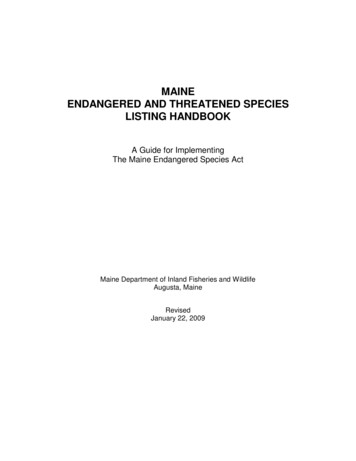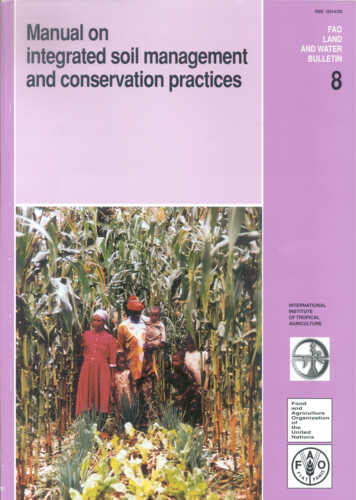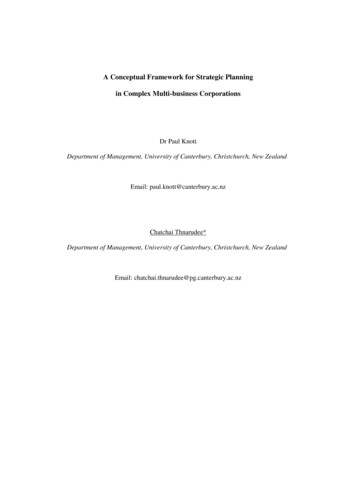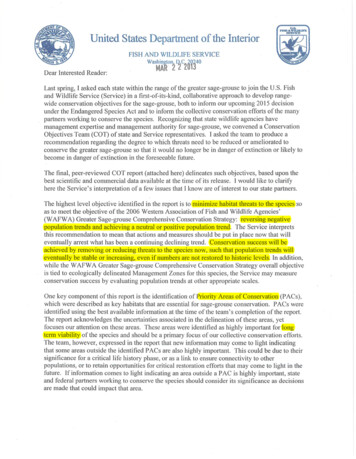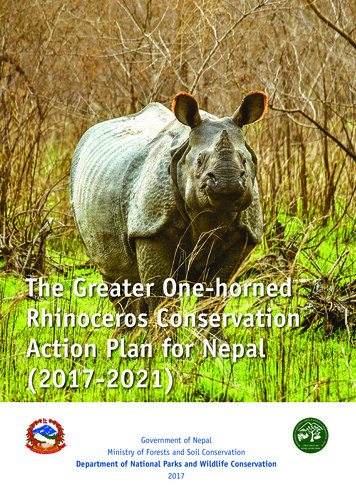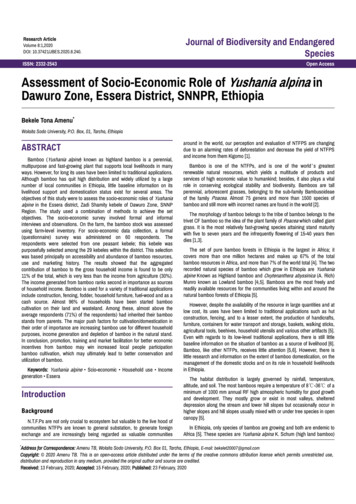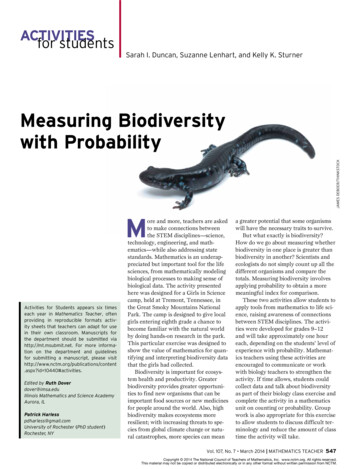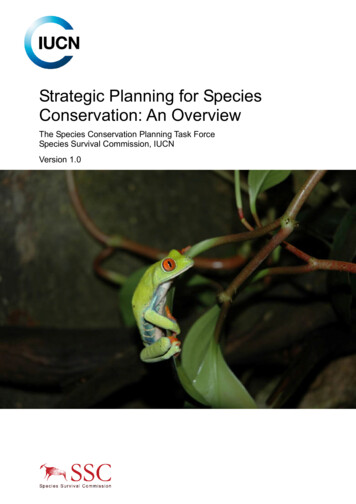
Transcription
Strategic Planning for SpeciesConservation: An OverviewThe Species Conservation Planning Task ForceSpecies Survival Commission, IUCNVersion 1.0
Strategic Planningfor Species Conservation:An OverviewVersion 1.0
A scorpion fish (Scorpaenidae) in the Mediterranean sea, near Escala, SpainIUCN Photo Library Christian Laufenberg
Strategic Planningfor Species Conservation:An OverviewVersion 1.0The Species Conservation Planning Task ForceSpecies Survival Commission, IUCNIUCN/Species Survival CommissionSeptember 2008
The designation of geographical entities in this document, and the presentation of the material,do not imply the expression of any opinion whatsoever on the part of IUCN or the organizationsof the document authors and editors concerning the legal status of any country, territory, orarea, or of its authorities, or concerning the delimitation of its frontiers or boundaries.The views expressed in this publication do not necessarily reflect those of IUCN.Production of this document was made possible by the generous support of the WildlifeConservation Society in providing editorial and production services.Support for the work of the IUCN/SSC Species Conservation Planning Task Force wasprovided by grants from the Forestry Bureau of the Taiwan Council of Agriculture, the ChicagoBoard of Trade Endangered Species Fund, administered by the Chicago Zoological Society,and the IUCN Species Survival Commission. Working meetings of the Task Force weregenerously hosted by the Wildlife Conservation Society, Budapest Zoo, and the WildCRU of theUniversity of Oxford.Published by: IUCN, Gland, Switzerland.Copyright: 2008 IUCN, International Union for Conservation of Nature and Natural ResourcesReproduction of this publication for educational or other non-commercial purposes is authorized withoutprior written permission from the copyright holder provided the source is fully acknowledged. Reproductionof this publication for resale or other commercial purposes is prohibited without prior written permission ofthe copyright holder.Citation: IUCN/Species Survival Commission. 2008 Strategic Planning for Species Conservation: AnOverview. Version 1.0. Gland, Switzerland: IUCN. 22pp.ISBN:978-2-8317-1123-2Cover design and Layout by: Karin Svadlenak-Gomez.Cover photo: Red-eyed tree frog, Costa Rica, IUCN Photo Library IUCN / Julián Orozco Badilla.Document available online at: iew.pdf
ContentsPREFACE .VI1.THE EVOLUTION OF SSC’S PLANNING FOR SPECIES CONSERVATION. 12.A FRAMEWORK FOR STRATEGIC PLANNING FOR SPECIES CONSERVATION. 23.WHEN SHOULD A SPECIES CONSERVATION STRATEGY BE DEVELOPED?. 44.WHO SHOULD BE INVOLVED IN DEVELOPING A SPECIES CONSERVATIONSTRATEGY?. 55.STATUS REVIEW. 66.VISION AND GOALS . 97.OBJECTIVES. 118.ACTIONS . 129.USING A SPECIES CONSERVATION STRATEGY TO DEVELOP NATIONAL OR LOCALACTION PLANS. 1610.INTEGRATION OF SPECIES CONSERVATION STRATEGIES WITH OTHERCONSERVATION PLANNING EFFORTS . 1711.CONCLUSION . 19LITERATURE CITED . 21LEAD AUTHORS AND CONTRIBUTORS. 22v
PrefaceThe global community recognises the importance of conserving nature. Species and theirinterrelationships – including their relationship to people – are the very fabric of nature. In aneffort to save species and overall biodiversity, a number of approaches to conservation havebeen suggested. Some focus on protected areas, ecosystems, or other area-basedclassifications such as hotspots, ecoregions, Important Bird Areas, Important Plant Areas,and so on. Some such approaches also seek to ensure that the ecosystem processes andstructures which support nature are maintained. Although critical to nature conservation,area-based approaches are insufficient on their own. Many species, and species groups,need special attention, requiring species-focused conservation strategies.The Species Survival Commission (SSC), created in 1949, is the largest of IUCN’s sixvolunteer commissions. With some 8,000 scientists, government officials, and conservationleaders worldwide, the SSC membership is an unmatched source of information aboutspecies conservation.SSC members provide technical and scientific advice togovernments, international conventions, and conservation organizations throughout theworld. SSC also provides the best available information critical to the development of toolsfor species conservation such as the IUCN Red List of Threatened SpeciesTM. SSC worksprimarily through its 120 Specialist Groups, which focus on a wide range of plants andanimals, or on issues such as the effects of invasive species and the sustainable use ofwildlife. In addition, the IUCN Species Programme implements global species conservationinitiatives with and in support of SSC. This Species Programme’s support role includescoordinating the Red List, conducting communications work, and facilitating inputs toconventions (Web: www.iucn.org/species).In 2006, the Steering Committee of the Species Survival Commission authorized a SpeciesConservation Planning Task Force to review the existing and continually expandingexperience on species-focused conservation planning and to prepare a revised set ofguidelines, focused not only on the planning process, but also recommending how tomotivate greater levels of conservation investment through species-level strategic planning.Following a series of meetings and discussions, the Task Force members’ efforts to identifyand describe best practices in strategic planning for species conservation have now led tothe publication of Strategic Planning for Species Conservation: A Handbook.This Overview is a much shortened version of the new Handbook, in which we provideguidance to SSC Specialist Groups on when and how to prepare and promote what we callSpecies Conservation Strategies (SCS). This includes advice on how to conduct a thoroughStatus Review, how to develop, through broad consultation with stakeholders, a Vision andGoals for the conservation of a species or species group, how to set Objectives for achievingthe Vision and Goals, and how to address those Objectives through geographically andthematically specific Actions. For more details, including some recommended tools andmethods, we refer the reader to the Handbook.We expect the Handbook to be an evolving document, with further explanations and links toreference materials, and possible alternative ways of going about some of the steps, addedover time as more is learned about the best ways to achieve effective species conservation.We hope that it will inspire conservation practitioners and partners in the private and publicsectors to use the methods we recommend for developing SCSs, and through thatmechanism to achieve our shared need for a world where people and the rest of naturethrive together for generations to come.vi
AcknowledgementsThe guidelines presented in this document were developed through the work of SSC’sSpecies Conservation Planning Task Force (the members are listed below). The Task Forcewould like to express our thanks to the SSC Chair Holly Dublin and to the SSC SteeringCommittee for envisioning and then creating the Task Force, and for their support andguidance throughout. Other members of the Commission and of the IUCN SpeciesProgramme also provided insights and feedback both on the work of the Task Forcegenerally and on this document in particular.Funding for the work of the Task Force was provided by SSC and by grants from theForestry Bureau of the Taiwan Council of Agriculture and the Chicago Board of TradeEndangered Species Fund. Working meetings of the Task Force were generously hosted bythe Wildlife Conservation Society, Budapest Zoo, and the Wildlife Conservation ResearchUnit (WildCRU) of the University of Oxford. The organizations of the Task Force membersprovided not only the substantial expertise and time of those members, but also often fundedthe costs of their travel to Task Force meetings.Funding for professional editing and production of this document was provided by theWildlife Conservation Society. Without the skilled and very dedicated copy editing by KarinSvadlenak-Gomez, this document would not have been produced. The Task Force isgrateful for her assistance.Finally, the ideas and guidelines in this document arose from the experience and insights ofthe many people who have worked to develop effective Species Conservation Strategiesand Action Plans, both within IUCN/SSC Specialist Groups and within many governmentalagencies and non-governmental conservation organizations. We thank all who have workeddiligently and with passion to conserve species diversity in the past and especially those whowill use these guidelines to help achieve more successful conservation of species for thefuture.SSC Species Conservation Planning Task Force: Editorial Team Simon Hedges, Wildlife Conservation Society; Co-chair, IUCN/SSC Asian ElephantSpecialist Group; Large Bovini Coordinator, IUCN/SSC Asian Wild Cattle SpecialistGroupRobert Lacy, Chicago Zoological Society; Chair, IUCN/SSC Conservation BreedingSpecialist GroupDavid Mallon, Dept of Biological Sciences, Manchester Metropolitan University; Cochair, IUCN/SSC Antelope Specialist GroupPhilip McGowan, Director, World Pheasant Association; Co-ordinator, WPAIUCN/SSC Galliformes Specialist GroupsPhilip Miller, Senior Program Officer, IUCN/SSC Conservation Breeding SpecialistGroupEric Sanderson, Wildlife Conservation SocietyClaudio Sillero-Zubiri, Wildlife Conservation Research Unit (WildCRU), University ofOxford; Chair, IUCN/SSC Canid Specialist GroupKarin Svadlenak-Gomez, Wildlife Conservation Society (Copy Editor)Rosie Woodroffe, Zoological Society of London; Coordinator, African Wild DogWorking Group, IUCN/SSC Canid Specialist Groupvii
Other members of the SSC Species Conservation Planning Task Force Julian Blanc, CITES MIKE (Monitoring the Illegal Killing of Elephants) ProgrammeUrs Breitenmoser, University of Bern; Co-chair, IUCN/SSC Cat Specialist Group;Large Carnivore Initiative for Europe Working GroupDena Cator, IUCN Species ProgrammePhilippe Chardonnet, International Foundation for the Conservation of Wildlife; Cochair, IUCN/SSC Antelope Specialist GroupHolly Dublin, Chair, IUCN Species Survival Commission; Chair, IUCN/SSC AfricanElephant Specialist GroupRichard Emslie, Scientific Officer, IUCN/SSC African Rhino Specialist GroupDavid Garshelis, Minnesota Department of Natural Resources; Co-chair, IUCN/SSCBear Specialist GroupJohn Haslett, Department of Organismal Biology, University of SalzburgMargaret Kinnaird, Mpala Research Centre and Conservancy and the WildlifeConservation SocietySusan Lieberman, World Wide Fund For Nature (WWF)Michael Maunder, Fairchild Tropical Botanic Garden; IUCN/SSC Plant ConservationSub-CommitteePatricia Medici, Chair, IUCN/SSC Tapir Specialist GroupRussel Mittermeier, Conservation International; Chair, IUCN/SSC Primate SpecialistGroupDeborah Procter, IUCN/SSC Invertebrate Conservation Sub-CommitteeJohn Robinson, Wildlife Conservation SocietyPritpal Soorae, Environment Agency, Abu Dhabi; Program Officer and Reptiles andAmphibians Section Chair, IUCN/SSC Re-introduction Specialist Groupviii
1.The evolution of SSC’s planning for speciesconservationSince the first SSC Action Plan was published in 1987, more than 60 Plans have beenpublished in a series that is now well recognised1. The majority of the Action Plans coveredmammals, especially the larger charismatic species, such as primates and wild cats, butthere are also Action Plans for orchids, conifers, dragonflies, several groups of birds (forexample, cranes, parrots, and pheasants), fishes, and other groups. According to SSC, thisseries “ assesses the conservation status of species and their habitats, and specifiesconservation priorities. The series is one of the world’s most authoritative sources ofspecies conservation information available to natural resources managers, conservationists,and government officials around the world” (IUCN/SSC 2002).Action Plans have proved very successful in collating large quantities of useful informationon the distribution, status, and habitats of species or groups of species, and in identifying(typically biological) priorities and gaps in knowledge. Most of these Plans, however, havestimulated only limited conservation effort. Whilst the standard of biological informationcontained in the Plans attracted widespread admiration, their relevance to practicalconservation programmes was often not clear, because: It was not clear who the target audience was; They were mostly compiled by Specialist Groups with limited resources; There were no clear guidelines on what the Plans should contain; There was rarely a clear link to action (IUCN/SSC 2002).We intend the guidelines in this document to address these issues and to accommodateother developments in species conservation planning.The concept of a SpeciesConservation Strategy (SCS) that we outline here has a taxonomic focus that is narrowenough to allow development of the specific Actions needed to ensure conservation of thespecies. This contrasts with, but builds upon, the broader assessment of all species within agroup that was undertaken in many of the earlier Action Plans. It also means that a numberof Strategies might be developed to cover many (but often not all) of the species that wereincluded within existing Action Plans.However good these guidelines may be, we emphasise that the resulting SCSs will only besuccessful if they are implemented. As with Action Plans, SCSs must be based on soundconservation science, but in contrast with the way past Action Plans have often beenprepared, they should be prepared through inclusive, participatory processes that lead tobroad ownership. This will improve prospects for implementation and, ultimately, sustainedconservation successes. Both SCSs and Action Plans are only tools and are of no usewithout effective implementation.1For online access to published IUCN/SSA Species Action Plans es/resources/publications/index.cfm (accessed 16September 2008)1
2.A framework for strategic planning for speciesconservationA SCS, as described in this document, is a range-wide (or in some cases a regional)blueprint for saving a species or group of species. The approach we outline here is one of anumber of possible forms that a SCS could take and it should not be misunderstood as aninflexible prescription. The process we recommend has been tried successfully in a numberof instances, though sometimes the terminology and definitions used by conservationplanners may have been slightly different even if they may have referred to essentially thesame elements of the SCS process we discuss here. In this Overview, and in theHandbook, we have explained the principal terms used to clarify our meaning; but we readilyadmit that ours are not the only valid definitions.With these qualifications in mind, we recommend that a SCS contain a Status Review, witha Vision and Goals for saving the species, Objectives that need to be met to achieve theGoals, and Actions that will accomplish those Objectives. The steps involved in preparing aSCS follow a logical framework approach, and can be summarised as follows: Compile and refine a range-wide Status Review (incorporating a threatanalysis), both in preparation for and at a workshop (or workshops) involvingspecies specialists and other stakeholders (see Chapter 6). This StatusReview defines the historical and current distribution of the species, statespopulation sizes (or at least gives some measure of relative abundance),evaluates population trends, and identifies losses and threats. The StatusReview should, where available, be informed by the appropriate Red ListAssessment(s) and supporting documentation from the Red List Unit of theIUCN Species Programme and the Species Information Service (SIS). Thecompleted Status Review should also in turn feed back into the Red Listprocess. Formulate a range-wide (or in some cases a regional) Vision, which is aninspirational description of what participants want to achieve (a description of“the desired future state” for the species) and a set of associated Goals. TheGoals capture in greater detail what needs to be achieved, and where, tosave the species (see Chapter 7). The Goals are the Vision rephrased inoperational terms. Both the Vision and the Goals have the same broad, longterm, spatio-temporal scale. The Goals should have concrete Targets2associated with them, which are a medium-term (typically 5–10 years) subsetof the Goals. Goal Targets represent those Goals (and/or the necessarysteps towards those Goals) that can realistically be achieved over the lifetimeof the Strategy. Like all targets, Goal Targets should be SMART3 Compile a set of Objectives needed to achieve the Goal(s) over the statedtime-span. Objectives must address the main threats identified in the StatusReview process and each Objective should also have one or more SMARTTargets (see above). This part of the process further identifies the obstaclesto achieving the Vision and Goals. In fact, Objectives can be thought of asthe inverse of threats, problems, and constraints. They are statements ofwhat would need to be accomplished to result in a reversal of or halt to the3The acronym “SMART” refers to targets and indicates that they should be Specific, Measurable,Achievable, Realistic, and Time-bound.2
threats (see Chapter 8). Objectives are typically developed using a combinedthreat analysis and a broader problem analysis (see Chapter 8). Decide on Actions to address each Objective Target. Actions are the detailedsteps that lay out what needs to be done, where, and when (see Chapter 9).They are short-term (typically 1–5 years).The hierarchy of the components of a SCS are graphically displayed in Figure 2.1.Figure 2.1 Relationships between components of the SCSOur recommended approach differs from the earlier Action Planning process in itsrequirement to explicitly define what it would mean to save a species, development of aplan that is judged sufficient to achieve that end, and an emphasis on multi-stakeholderparticipation with (as applicable) species specialists, range State government staffresponsible for implementation, members of local communities and social movements,regional politicians (if relevant), and so on, explicitly included in all steps.We have attempted to design a set of suggested guidelines for the preparation ofcomprehensive and practical Species Conservation Strategies, while bearing in mind theneed to tailor approaches to particular target groups and scenarios. While there cannot be a“one size fits all” method, we believe that conservation planners will benefit from being ableto refer to these guidelines when preparing conservation plans. It is hoped that oursuggestions will lead to conservation strategies that are based on sound biologicalapproaches, and prepared through inclusive, participatory processes to generate the senseof ownership needed to improve prospects for implementation and, ultimately, successfulconservation.3
The SCS process delineated here sets out a simple, robust conceptual framework that canbe applied at all taxonomic or spatial levels of strategic planning. These levels could includesingle species (whether restricted range endemics or widespread generalists), groups orsuites of species, and individual subspecies, as well as at global, regional, or nationalscales.Importantly, the process needs to include ongoing compilation and review of data on speciesstatus and distribution for the Status Review, implementation of the recommended Actions,monitoring of Targets at the Goals, Objectives, and Actions level, and a process forcontinuing review and refinement. Rarely, if ever, will the data and participants’ ability topredict and control the future be adequate to give us much confidence that a strategy, whenfirst developed, will guarantee the desired future for the species. Adaptive management hasto be integral to the SCS philosophy. A SCS therefore needs to include a monitoringframework alongside implementation of its Actions. One useful component of such anapproach is to publish the SCS as an electronic or other living document rather than in print,subject to continual refinement (but with adequate version control so that it can be properlyreferenced and progress can be traced).3.When should a Species Conservation Strategybe developed?Species-focused SCSs are appropriate when the relevant SSC Specialist Group or otherauthority for a species or a group of species deems coordinated conservation attentionnecessary. The need for coordination may arise because the geographic range of thespecies or species group straddles political boundaries or multiple ecological zones and sorequires different political entities and groups of scientists, conservationists, managers, andpolicy-makers to act in concert, or it may arise because the level of threat is endangering theviability of key populations, their ecological functions, and/or their habitat. The completion ofa Red List assessment (see Baillie et al. 2004; and http://www.iucnredlist.org) or an updatedspecies assessment may be an opportune time to initiate the development of a SCS forthose species that are listed as threatened.Before embarking on the preparation of a new SCS, it should be clear that the processrequires substantial effort, and that time, funds and personnel have to be available todevelop the strategy. Dedicated staff and resources will often be needed to implement theresulting SCSs. One of the first steps required for strategic planning, therefore, will usuallybe to raise funds to support the process, although this can coincide with the equallynecessary step of identifying and gaining the support of key stakeholders (see Chapter 4),as both governments and non-governmental organizations are likely to support a processboth financially and with their participation if they expect that it will meet their needs. A welldeveloped and broadly endorsed Strategy can be a great help in raising the funds andgetting the agency and institutional commitments to implement the Actions needed toachieve the desired Goals and Objectives.Another consideration is the taxonomic scope and geographic range for which a SCSmay be prepared. Our proposed approach can be applied to the spectrum of taxonomicgroupings, from a single or a small number of species to highly speciose groups. They canalso be applied across the spatial range, from taxa having wide geographic distributionsacross many countries, to those with extremely restricted geographic ranges. Regardless ofspecies, all the components of a SCS, as outlined in this document, can be included.4
However, the details of conservation planning and the emphasis, nature, and level of detailfor the various components of the strategy may be quite different.In some instances, a SCS may cover s-focusedGoals, Objectives, and Actions, if groupsof species face similar threats and hencerequire similar conservation responses.For example, some invertebrate groupsmay require planning for thousands ofpoorly known species.Developingindividual species-by-species Strategieswould be impossible for such groups.Yet it might be valuable to conduct StatusReviews that consider range, habitatrequirements, threats, changes inImage 3.1beetlein Nosara,Costa RicaPhoto3.1 AArhinocerosrhinocerosbeetle(Dynastessp.)IUCN Photo Library Joëlle Dufourabundance and distribution (and possiblyin Nosara, Costa Ricaspecies richness) for a group of similarIUCN Photo Library Joëlle Dufourspecies within an area; stakeholdersmight agree to a common Vision and Goals for the set of species; Objectives might definewhat needs to be accomplished to ensure protection of the suite of species; and Actionscould be determined that would result in meeting those Objectives.Multi-species SCSs would most commonly be prepared for a group of related species, but itmight also be beneficial to design such Strategies for a group of species that have commonecological roles (for example pollinators), share habitat types (such as reef fish), are linkedby strong ecological relationships (for instance, a predator and its prey), or face similarthreats in similar areas and at similar spatial scales (such as cheetahs (Acinonyx jubatus)and African wild dogs (Lycaon pictus)). It may also be appropriate to develop a higher-levelSCS for a group of species, with more detailed species-specific SCSs for a fewrepresentative, particularly threatened, or focal species from the group.4.Who should be involved in developing aSpecies Conservation Strategy?To ensure that SCSs have the best chance of being implemented, the SCS processemphasises multi-stakeholder participation. Range State government staff and conservationNGO staff, species conservation specialists (some of whom may of course work forgovernment agencies and NGOs), representatives of local communities or local authorities(when appropriate), the private sector (for example, logging or mining companyrepresentatives, or tourism operators), and other key stakeholders should be explicitlyincluded in all steps. Stakeholders are all those individuals who demonstrate some combination ofconcern (about the outcome of a SCS process), expertise (anyone who has information or resourcesrequired to participate in a SCS process), and/or power (anyone who is able to either block orfacilitate recommendations which result from the SCS process). That is to say, representativesfrom all these stakeholder groups should participate in the Status Review part of the processas well as in defining the Vision, Goals, Objectives, and Actions.Clearly, the relevant specialists for the species concerned have to be involved in developingthe Vision, Goals, Objectives, and Actions. In addition to being stakeholders in their ownright, such species specialists are often best placed to formulate the “species’ eye view” thatthe overall SCS should promote in order to best conserve the species. However, it bearsrepeating that it is also vitally important for range State stakeholders to be involved in this5
process because of their understanding of the context in which the conservation activitieswill be conducted, and because their participation is a prerequisite for the necessaryownership and sense of responsibility for the SCS that leads to an enabling politicalenvironment and to action.SSC Specialist Groups can and, in most cases, should play a number of roles in the SCSprocess. For example, a Specialist Group will, as a result of its Red Listing activities, have aclear idea of priority species for which to prepare a SCS. The Specialist Group will also bean appropriate body to organize the collation of data for the Status Review, and convene theworkshop in which the Status Review will be reviewed and/or revised and the rest of theSCS developed. Specialist Group Chairs and other members should be involved inidentifying the most appropriate participants, ensuring good representation from range Stategovernments and other key stakeholder groups. Another role that particularly lends itself toSpecialist Groups is maintaining an up-to-date database on the species’ status anddistribution following the Status Review. IUCN’s neutral inter-governmental status has in thepast given governments the confidence to submit data to SSC-maintained databases, whichis something that they may not be willing to do if the databases are maintained by an NGO.5.Status ReviewThe Status Review is a summary of information about the current biological, socio-economic,and cultural status of the species. Status Reviews are time-bound and geographicallyscaled to the range of the species; they are also spatially explicit, ideally supported byappropriate geographic information system (GIS) analyses and metadata, and conductedaccording to standardized protocols. They include summaries of recent observations,ranging patterns, important populations, population trends, threats, socio-economic andcultural importance, and already ongoing conservation efforts. In other contexts, StatusReviews might be called status reports or species profiles and have been an important partof IUCN/SSC Action Plans in the past.The Status Review should rely on a thoughtful and inclusive analysis of scientific andtraditional knowledge and be inclusive of the major stakeholders with informa
Action Plans have proved very successful in collating large quantities of useful information on the distribution, status, and habitats of species or groups of species, and in identifying (typically biological) priorities and gaps in knowledge. Most of these Plans, h
